74 Geography and Cosmology
Archeologists have measured the layout of Teotihuacan, situating the Pyramid of the Sun within the landscape to better understand how the Olmec peoples originally used the Pyramid of the Sun in conjunction with the environment. For example, the pyramid was deliberately oriented slightly north of west (approximately 15.5 degrees) toward the horizon point of the setting sun on two specific days: August 13 and April 29. These two approximate dates form one 260-day divinatory almanac count. We know from historical records that the Aztecs used a 260-day calendar called the tonalpohualli (meaning “the count of days”) in Nahuatl. Remember, the Aztecs are the Native peoples who associate themselves with the Olmec peoples who built Teotihuacan. This cycle of tonalpohualli consists of thirteen numbers and twenty signs, which rotated through the 260 days. In this sacred calendar, the numbers 1-13 were paired with animal signs like Alligator, Deer, Lizard, and Snake or more abstract signs like House, Wind, and Death. In this calendrical system, dates took the form of “1 Alligator” or “12 Wind” rather than something like “October 12, 1492.” Why is that date important?
The ancient Nahua drew additional cosmological meaning from the completion of this calendrical cycle known as tonalpohualli. It just so happens that 13 cycles of the names (Alligator, Wind, Snake, etc.) equated to 20 cycles of the numbers (1-13). When this happened, the entire year was very special and filled with sacred meaning. It’s really difficult to convey this special meaning to you if this is the first time you have thought about religion, the calendar, and the passing of time.
In the United States, we celebrate religious festivals throughout the year, but the years themselves have no meaning. True that we may still celebrate a religious holiday like Christmas, Hanukah, or Ramadan, but 1987 had no sacred meaning of its own nor did the year 2015. To offer another example, you may have realized we have “leap years” in our calendar, which occur in February every four years. This creates a new day, February 29, but we do not endow this event with sacred meaning as Native peoples in Mesoamerica would have. Think of the aforementioned year in the calendar of tonalpohualli—when the 13 cycles of names overlapped with the 20 cycles of numbers—as being special like “leap year” but for the entirety of the year, rather than a single day in February. In the ancient Nahua world, this event would have been very sacred indeed.
The calendar tonalpohualli was so sacred that it guided the construction of monumental buildings. For example, the original base of the Pyramid of the Sun measures exactly 260 varas, a Spanish term for a measure found throughout the ancient world as it comprised the distance from one’s chest to one’s fingertip. The number of varas (i.e. 260) intentionally mimicked the 260 days in the ancient Nahua calendar. The pyramid itself was sacred space as it represented the totality of time in the tonalpohualli.
The original Pyramid of the Sun stood as the largest single-phase structure in the pre-Columbian New World. The Pyramid of the Sun was built over a cave. Caves were often interpreted to be portals to the spiritual world in many Mesoamerican cultures. In this case, access to the Pyramid of the Sun was obtained through a cave entrance on the west, where the sun set. The alignment of the cave entrance and the setting sun was crosscut at right angles by a sacred causeway known as the Street of the Dead with the Pyramid of the Sun situated at its northern terminus.
Scholars believe all the pyramids served as funerary monuments and honored certain deities, but a more in-depth understanding of how the entire complex was used remains elusive. Artwork from the Classic Period (roughly 300 CE – 950 CE) has helped scholars to identify two major deities worshipped at Teotihuacan: a male storm god paired with a female fertility deity. The male storm god is believed to have been a precursor to the Aztec storm deity Tlaloc. The female deity, sometimes referred to as the “great goddess,” is thought to have represented fertility and abundance. Much is known about Tlaloc in the sixteenth century after Spanish colonizers recorded local traditions. Tlaloc controlled the wind and rain, so he became an important deity for Nahuatl-speaking agriculturalists. By appeasing Tlaloc to provide good weather and a bountiful harvest, Nahua peoples like the Aztecs could ensure prosperity in the future. From the earliest of times, we see that Nahua religious practices emphasized duality, hence the pairing of a male and female deity.
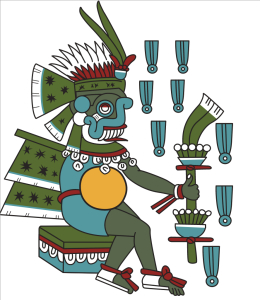
Note the goggle-like eyes of Tlaloc in this depiction. Profile views were common in Mesoamerican artwork.
Although the Aztecs have come and gone, images of Aztec gods remain popular throughout Mexico.

Duality continues to hold importance in modern Nahua religious rituals (discussed below), and, as a consequence, even numbers like 2 or numbers deriving from 4 remain highly significant. Pairs and the act of pairing have always been important in Nahua cosmology. The great Aztec pyramid known in Spanish as Templo Mayor (literally Great Temple) of Tenochtitlan (modern-day Mexico City) also worshipped two primary deities: Huitzilophochtli (the deity of war) and Tlaloc. The northern side of the temple was dedicated to Tlaloc and the pyramid-temple represented Tonacatepetl, the mountain home of Tlaloc. The architecture was designed to mimic nature and harness its power. Pyramids symbolically signified mountains, and mountains were revered because they pierced the heavens and brought the rains.
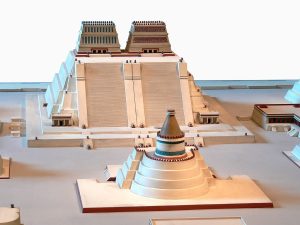
The Aztecs constructed these grandiose pyramids after learning about Olmec religious traditions and methods of construction. For example, the Templo Mayor underwent seven separate phases of construction. The Aztecs first constructed the Templo Mayor c. 1325 CE. They expanded and built upon the original pyramid six additional times. Note the contextual significance as the pyramids were always in conversation with the landscape. The pyramid evoked a mountain and its peaks. By building structures similar to those found in nature, the Aztecs hoped to better communicate with the natural and supernatural worlds.
The sixteenth-century Spanish chronicler Fray Diego Durán (c. 1537-1588 CE) wrote much about the Aztecs and Nahua society more broadly. We learn from his writings that Tlaloc was revered as a weather deity, associated with storms, thunder, and lightning. Tlaloc’s name, and hence his literal point of origination, was given to a mountain called Tlalocan (meaning the place of Tlaloc) in Nahuatl. Early Nahua peoples noticed that hail, thunderbolts, and clouds emanated from the mountain, leading them to conclude Tlaloc resided there.
On the summit of the Tlalocan mountain stood a courtyard surrounded by a protective wall eight-feet high. A man-made forest was set up in the courtyard to imitate the surrounding landscape. The Aztecs placed bushes, branches, and rocks in a specific arrangement, with a tall tree in the middle. Four smaller trees surrounded the largest one to represent fertility. The smaller trees were the symbolic offspring of the largest tree. The largest tree was called tota in Nahuatl, meaning “our father.” By tending to the progenitor, i.e. tota (our father), the Aztecs hoped they would be rewarded by gods like Tlaloc.
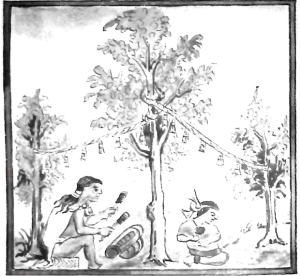
The courtyard at Tlalocan also housed a shrine dedicated to Tlaloc. A stone carving of Tlaloc was placed on an altar alongside other carvings of Nahua deities. These smaller carvings represented personifications of the surrounding hills and cliffs associated with the great mountain of Tlalocan. Tlaloc was similarly personified, meaning people made him into a tangible object, shaped into a human silhouette and decorated with feathers and jewelry. In his right hand, Tlaloc carried a purple wooden thunderbolt. In his left hand, Tlaloc held a leather bag filled incense known as copal.
Depictions of Tlaloc can still be found on paper and in stone. The sculpture below shows Tlaloc with goggle-like eyes and cat-like fangs. In addition to the terrifying sound of thunder, Tlaloc was associated with the roars of powerful predators like jaguars. The light blue coloring symbolized water, and the pottery vessel itself is thought to have carried water during important ancient festivals. Below the bottom lip, where the chin would be, one can see a forked tongue. This may have represented the tongue of a snake. The four peaks on Tlaloc’s headdress signify four hills surrounding the Aztecs, where Tlaloc kept his life-sustaining water.
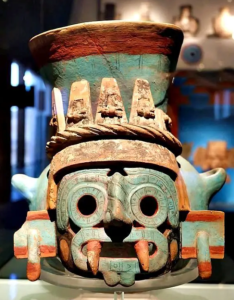
In the Aztec calendar (tonalpohualli in Nahuatl) Tlaloc was revered around April 29, which drew locals from the surrounding area. The ceremony took place after the corn (cintli in Nahuatl) was harvested. Locals then provided offerings of food as thanks to the gods for the fertile, life-sustaining harvest. Locals brought turkeys, hens, chocolate, and various kinds of bread. In addition to food, Native peoples might offer a precious jewel, feather, stone, or another item of high value to ask Tlaloc for “good fortune” in the coming year. Good fortune usually entailed asking the gods for a longer life in the here and now, more food for hungry bellies, or temperate seasons for farmers.
According to the sixteenth-century Spanish chronicler, Fray Bernardino de Sahagún, Nahuatl-speaking peoples applied the term “tlalohqueh,” itself the plural for Tlaloc, to mean the “makers of rain.” We see an expanded application of Tlaloc to humans who could mediate between natural and supernatural worlds. More modern terms for tlaloqueh might translate to “shamans” or, the now preferred academic term, ritual specialists. To clarify, Nahua and Aztec ritual specialists (or “shamans”) were called tlaloqueh. Nevertheless, those of us unfamiliar with this Indigenous language need to keep in mind that this term also derived from the rain deity Tlaloc. A lengthier but more accurate translation into English for tlaloqueh might be “ritual specialists of Tlaloc” to highlight the term’s derivation from Tlaloc.
Those tlaloqueh (meaning ritual specialists of Tlaloc) who controlled the weather commanded much respect locally. Rain helped grow the crops that fed people. Indigenous ritual specialists who successfully channeled nature’s power seemingly guaranteed prosperity for the future.
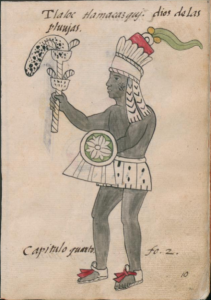
According to Fray Bernardino de Sahagún, the “makers of rain,” tlalohqueh in Nahuatl, were known to bring torrents from the sky such as hail, thunder, rain, and floods. Such elements helped the trees and plants to sprout, blossom, bloom, and ripen, which in turn helped humans to survive. These human tlalohqueh painted their faces black with liquid rubber and a paste made from amaranth seeds. The picture above shows one individual dressed in a crown of heron feathers, sandals, and a plaited-reed banner. Note how the natural environment was harnessed to give these tlaloqueh additional power. Actions like painting one’s body or wearing feathers helped the tlaloqueh directly engage with their natural environment and, so it was hoped, harness the power of nature itself.
At their broadest level, deities like Tlaloc and human intermediaries such as the tlaloqueh signified fertility and abundance. The weather brought by Tlaloc constituted one part of a reciprocal relationship wherein spiritual intermediaries (e.g. tlaloqueh or ritual specialists) showed gratitude through their offerings. The personification of Tlaloc, as seen in the images above, was used as a conduit to the spiritual world. Labelling, drawing, and carving deities helped these early Nahua peoples to interact directly with the supernatural, thus gaining control over life itself.
